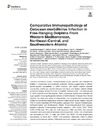Please use this identifier to cite or link to this item:
https://accedacris.ulpgc.es/jspui/handle/10553/69867
| Title: | Comparative immunopathology of cetacean morbillivirus infection in free-ranging dolphins from Western Mediterranean, Northeast-Central, and Southwestern Atlantic | Authors: | Diaz Delgado, Josue Groch, Kátia R. Ressio, Rodrigo Riskallah, Isis P.J. Sierra Pulpillo, Eva María Sacchini , Simona Quesada Canales, Ildefonso Óscar Arbelo Hernández, Manuel Antonio Fernández Rodríguez, Antonio Jesús Santos-Neto, Elitieri Ikeda, Joana de Carvalho, Rafael Ramos de Freitas Azevedo, Alexandre Lailson-Brito, Jose Flach, Leonardo Kanamura, Cristina T. Fernandes, Natália C.C.A. Cogliati, Bruno Centelleghe, Cinzia Mazzariol, Sandro Di Renzo, Ludovica Di Francesco, Gabriella Di Guardo, Giovanni Catão-Dias, José Luiz |
UNESCO Clasification: | 3105 Peces y fauna silvestre 310907 Patología |
Keywords: | Apoptosis Cetacean Morbillivirus Cytokines Histiocytes Immunopathogenesis, et al |
Issue Date: | 2019 | Journal: | Frontiers In Immunology | Abstract: | This is an open-access article distributed under the terms of the Creative Commons Attribution License (CC BY). The use, distribution or reproduction in other forums is permitted, provided the original author(s) and the copyright owner(s) are credited and that the original publication in this journal is cited, in accordance with accepted academic practice. No use, distribution or reproduction is permitted which does not comply with these terms. Cetacean morbillivirus (CeMV; Paramyxoviridae) causes epizootic and interepizootic fatalities in odontocetes and mysticetes worldwide. Studies suggest there is different species-specific susceptibility to CeMV infection, with striped dolphins (Stenella coeruleoalba), bottlenose dolphins (Tursiops truncatus), and Guiana dolphins (Sotalia guianensis) ranking among the most susceptible cetacean hosts. The pathogenesis of CeMV infection is not fully resolved. Since no previous studies have evaluated the organ-specific immunopathogenetic features of CeMV infection in tissues from infected dolphins, this study was aimed at characterizing and comparing immunophenotypic profiles of local immune responses in lymphoid organs (lymph nodes, spleen), lung and CNS in CeMV-molecularly (RT-PCR)-positive cetaceans from Western Mediterranean, Northeast-Central, and Southwestern Atlantic. Immunohistochemical (IHC) analyses targeted molecules of immunologic interest: caspase 3, CD3, CD20, CD57, CD68, FoxP3, MHCII, Iba1, IFNγ, IgG, IL4, IL10, lysozyme, TGFβ, and PAX5. We detected consistent CeMV-associated inflammatory response patterns. Within CNS, inflammation was dominated by CD3+ (T cells), and CD20+ and PAX5+ (B cells) lymphocytes, accompanied by fewer Iba1+, CD68+, and lysozyme+ histiocytes, mainly in striped dolphins and bottlenose dolphins. Multicentric lymphoid depletion was characterized by reduced numbers of T cells and B cells, more pronounced in Guiana dolphins. Striped dolphins and bottlenose dolphins often had hyperplastic (regenerative) phenomena involving the aforementioned cell populations, particularly chronically infected animals. In the lung, there was mild to moderate increase in T cells, B cells, and histiocytes. Additionally, there was a generalized increased expression of caspase 3 in lymphoid, lung, and CNS tissues. Apoptosis, therefore, is believed to play a major role in generalized lymphoid depletion and likely overt immunosuppression during CeMV infection. No differences were detected regarding cytokine immunoreactivity in lymph nodes, spleen, and lung from infected and non-infected dolphins by semiquantitative analysis; however, there was striking immunoreactivity for IFNγ in the CNS of infected dolphins. These novel results set the basis for tissue-specific immunophenotypic responses during CeMV infection in three highly susceptible delphinid species. They also suggest a complex interplay between viral and host's immune factors, thereby contributing to gain valuable insights into similarities, and differences of CeMV infection's immunopathogenesis in relation to body tissues, CeMV strains, and cetacean hosts. | URI: | https://accedacris.ulpgc.es/handle/10553/69867 | ISSN: | 1664-3224 | DOI: | 10.3389/fimmu.2019.00485 | Source: | Frontiers in Immunology [ISSN 1664-3224], v. 10 (Marzo 2019) |
| Appears in Collections: | Artículos |
SCOPUSTM
Citations
16
checked on Jun 8, 2025
WEB OF SCIENCETM
Citations
16
checked on Jun 8, 2025
Page view(s)
238
checked on May 17, 2025
Download(s)
114
checked on May 17, 2025
Google ScholarTM
Check
Altmetric
Share
Export metadata
Items in accedaCRIS are protected by copyright, with all rights reserved, unless otherwise indicated.
